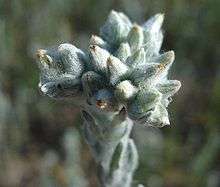Filago (plant)
Filago is a genus of plants in the sunflower family, native to Europe, Asia, and North Africa. They are sometimes called cottonroses or cudweeds.[2][3][4][5][6]
| cottonroses cudweeds | |
|---|---|
 | |
| Filago arvensis | |
| Scientific classification | |
| Kingdom: | |
| (unranked): | |
| (unranked): | |
| (unranked): | |
| Order: | |
| Family: | |
| Tribe: | |
| Genus: | Filago |
| Synonyms[1] | |
| |
The name cudweed comes from the fact that they were once used to feed cows that had lost the ability to chew the cud.[7]
Several species are sometimes treated as members of genus Logfia.
Description
They bear woolly, cottony heads of flowers. They have narrow strap-shaped untoothed leaves. The flower heads are small, gathered into dense, stalkless clusters. The fruits have a hairy pappus,[8] or modified calyx, the part of an individual disk, ray or ligule floret surrounding the base of the corolla, in flower heads of the plant family Asteraceae.
Species
The following species are known.[1]
- Filago abyssinica Sch.Bip. ex A.Rich.
- Filago aegaea Wagenitz
- Filago anatolica (Boiss. & Heldr.) Chrtek & Holub
- Filago argentea (Pomel) Chrtek & Holub
- Filago arvensis L.
- Filago asterisciflora (Lam.) Sweet
- Filago californica Nutt.[9][10] - California cottonrose
- Filago carpetana (Lange) Chrtek & Holub
- Filago clementei Willk.
- Filago congesta DC.
- Filago contracta (Boiss.) Chrtek & Holub
- Filago cretensis Gand.
- Filago crocidion (Pomel) Chrtek & Holub
- Filago davisii (Holub ex Grierson) Feinbrun
- Filago desertorum Pomel
- Filago duriaei Batt.
- Filago duriaei Coss. ex Lange
- Filago eriocephala Guss.
- Filago eriosphaera (Boiss. & Heldr.) Chrtek & Holub
- Filago filaginoides (Kar. & Kir.) Wagenitz
- Filago fuscescens Pomel
- Filago gallica L. - narrow leaved cudweed
- Filago germanica (L.) Hudson - common cudweed
- Filago heterantha (Raf.) Guss.
- Filago hurdwarica (Wall. ex DC.) Wagenitz
- Filago huruarica Wagenitz
- Filago inexpectata Wagenitz
- Filago libyaca (Alavi) Greuter
- Filago linearifolia (Pomel) Chrtek & Holub
- Filago lojaconoi (Brullo) Greuter
- Filago longilanata (Maire & Wilczek) Greuter
- Filago lusitanica (Samp.) P.Silva
- Filago lutescens Jord. - red-tipped cudweed
- Filago mareotica Delile
- Filago mauritanica (Pomel) Dobignard
- Filago micropodioides Lange
- Filago minima (Sm.) Pers. - small cudweed
- Filago mucronata (Pomel) Chrtek & Holub
- Filago neglecta (Soy.-Will.) DC.
- Filago nevadensis (Boiss.) Wagenitz & Greuter
- Filago palaestina (Boiss.) Chrtek & Holub
- Filago perpusilla (Boiss. & Heldr.) Chrtek & Holub
- Filago petro-ianii Rita & Dittrich
- Filago prolifera Pomel
- Filago psilantha (Pomel) Chrtek & Holub
- Filago pygmaea L.
- Filago pyramidata L. - broad-leaved cudweed
- Filago ramosissima Lange
- Filago repens Scheele
- Filago sahariensis Chrtek & Holub
- Filago texana Scheele
- Filago tyrrhenica Chrtek & Holub
Photos
 Filago arvensis
Filago arvensis Filago minima, Small cudweed
Filago minima, Small cudweed
gollark: No. It WILL be dynamically allocate.
gollark: The compiler is wrong, gibson.
gollark: Well, this is perfect and without flaw.
gollark: tio!debug
gollark: ```c#define let int#define var char#include <stdlib.h>#include <string.h>#include <stdio.h>let main() { var *j = 0; var* q = malloc(50005000); for (let i = 131; i < 10000; i++) { j = malloc(i); strcat(q, j); strcat(q, "apiobee"); free(j); q = j; } var* lyricLy_bad = malloc(3); printf("%s", j);}```
References
- "Flann, C (ed) 2009+ Global Compositae Checklist". Archived from the original on 2014-11-26. Retrieved 2014-11-26.
- Linnaeus, Carl von. 1753. Species Plantarum 2: 927 in Latin
- Linnaeus, Carl von. 1753. Species Plantarum 2: 1199 addendum in Latin
- Tropicos, Filago L.
- Altervista Flora Italiana, genere Filago includes photos, drawings, + distribution maps
- Flora of China Vol. 20-21 Page 774 絮菊属 xu ju shu Filago Linnaeus, Sp. Pl. 2: 927, 1199, [add. post indicem]. 1753.
- Wild Flowers Of the British Isles Website
- Rose, Francis (1981). The Wild Flower Key. Frederick Warne & Co. pp. 377–380. ISBN 0-7232-2419-6.
- TJM2: Logfia filaginoides
- CalFlora Database: Logfia filaginoides
This article is issued from Wikipedia. The text is licensed under Creative Commons - Attribution - Sharealike. Additional terms may apply for the media files.